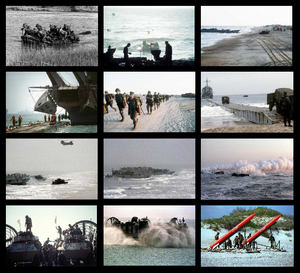Onslow Beach: Difference between revisions
imported>Stephen Ewen (expand) |
imported>Stephen Ewen (__NOTOC__) |
||
| Line 1: | Line 1: | ||
[[Image:OnslowBeachMilitaryExerciseGallery.png|thumb|300px|right|U.S. Military exercises conducted at Onslow Beach. Click on the image to be brought to a gallery.]] | __NOTOC__[[Image:OnslowBeachMilitaryExerciseGallery.png|thumb|300px|right|U.S. Military exercises conducted at Onslow Beach. Click on the image to be brought to a gallery.]] | ||
'''Onslow Beach''' is an 11-mile (17.7 kilometer) stretch of undeveloped beach along the Atlantic coast, located in Onslow County, in southeastern [[North Carolina]]. It is primarily used as amphibious training grounds for the [[Marine Corps Base Camp Lejeune]], of which it is part. The beach additionally supports the recreational needs of the Camp Lejeune community, as well to the surrounding community to the extent possible. The beach is also home to at least two [[endangered species]]. | '''Onslow Beach''' is an 11-mile (17.7 kilometer) stretch of undeveloped beach along the Atlantic coast, located in Onslow County, in southeastern [[North Carolina]]. It is primarily used as amphibious training grounds for the [[Marine Corps Base Camp Lejeune]], of which it is part. The beach additionally supports the recreational needs of the Camp Lejeune community, as well to the surrounding community to the extent possible. The beach is also home to at least two [[endangered species]]. | ||
| Line 12: | Line 12: | ||
As with most beaches that support important human and wildlife activity, [[beach restoration|restoration]] efforts to counter natural erosion are an ongoing effort. In September 2005, [[Hurricane Ophelia]] took an especial toll, not only causing significant [[erosion]] but nearly destroying the beach's historic Riseley [[Pier]]. | As with most beaches that support important human and wildlife activity, [[beach restoration|restoration]] efforts to counter natural erosion are an ongoing effort. In September 2005, [[Hurricane Ophelia]] took an especial toll, not only causing significant [[erosion]] but nearly destroying the beach's historic Riseley [[Pier]]. | ||
<br> | <br> | ||
[[Image:Onslow Beach.jpeg|thumb|750px|center|Onslow Beach in 2006--clearly not just for military uses.]] | [[Image:Onslow Beach.jpeg|thumb|750px|center|Onslow Beach in 2006--clearly not ''just'' for military uses.]] | ||
==References== | ==References== | ||
Revision as of 17:54, 23 May 2007
Onslow Beach is an 11-mile (17.7 kilometer) stretch of undeveloped beach along the Atlantic coast, located in Onslow County, in southeastern North Carolina. It is primarily used as amphibious training grounds for the Marine Corps Base Camp Lejeune, of which it is part. The beach additionally supports the recreational needs of the Camp Lejeune community, as well to the surrounding community to the extent possible. The beach is also home to at least two endangered species.
Uses: military and recreation
Since 1941 when Camp Lejeune opened after an act of Congress, the beach has been used by Marine, Navy, and army for various amphibious training exercises and landings. During times when no exercises are being conducted, the beach is popular for fishing, sunbathing, and shell collecting, especially during warmer months.
Wildlife
At least two endangered endangered species, one animal and one plant, reside at Onslow Beach. The first known instance of successful nesting north of Florida by a green sea turtle (Chelonia mydas) occured in 1980 at the beach (Schwartz et al., 1981). The specimen deposited 819 eggs in five nests. Tagged, she returned to the same stretch of the beach five years later to deposit 893 eggs, again in five nests. Today, sea turtles habitually nest at the beach.[1] A U.S. federally protected annual plant called seabeach amaranth grows on the beach's dunes and overwash flats. These are carefully managed to allow continued military use of the beach. Wild turkeys are abundant, and hunted in the area.
Restoration
As with most beaches that support important human and wildlife activity, restoration efforts to counter natural erosion are an ongoing effort. In September 2005, Hurricane Ophelia took an especial toll, not only causing significant erosion but nearly destroying the beach's historic Riseley Pier.
References
- ↑ Peterson, et al. "Tagged Green Turtle Returns and Nests Again in North Carolina". Marine Turtle Newsletter, 35:5-6, 1985.

